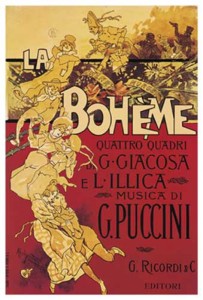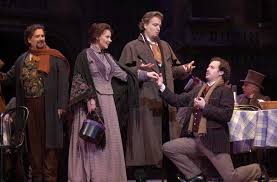La Bohème Throughout the Century
Posted on October 28th, 2013 by Anna in Uncategorized | No Comments »
When someone mentions opera, you may think of a classical piece that is mythical, romantic, and archaic, with a grandiose and melodramatic plot . Giacomo Puccini’s masterpiece, La Bohème, is all of these and more, but its relatable storyline and flawed but charismatic characters make the opera one of the most widely beloved of all time. First performed in 1896 at the Teatro Regio and conducted by Arturo Toscanini, La Bohème tells the story of four struggling artists living in the Latin Quarter of Paris during the 19th century. The Italian libretto was written by Luigi Illica and Giuseppe Giacosa, based off of the novel by Henri Murger, Scènes de la vie de bohème.
The characters, with all their idiosyncrasies, are so charmingly dysfunctional that they remain some of the most enduring in the opera world to this day. They are not gods or heroes or royalty; they are unemployed writers and intellectuals who get drunk, struggle to pay the rent, and fight with their significant others—all things that everyone can sympathize with, no matter what the time period. The story revolves around relationships that are as moving and complex as they are in the modern day. Rodolfo and Mimi love each other but keep trying to break up out of altruism. Marcello and Musetta drive each other crazy but their chemistry keeps them getting back together. Colleen and Schaunard occasionally show up for dinner and comic relief, and no one is really sure why they’re there.
But while the emotions and socials interactions of La Bohème are familiar, their scope is taken to operatic extremes. Rodolfo and Mimi’s on-and-off love isn’t just unfortunate—it’s doomed. The friends’ antics—outsmarting the landlord, burning their art, running out on the bill in a fancy restaurant—go beyond mere shenanigans and become legend. More than a simple love story, Rodolfo and Mimi’s tragic affair channels every love story that came before and after it. And as for the music, Puccini’s score provides some of the most widely sung arias and leitmotifs in the realm of both classical music and pop culture; “Che Gelida Manino,” as well as “O soave fanciulla,” and “Musetta’s Waltz” have become iconic since their inception.
Due to its massive popularity, La Bohème has been performed and recorded consistently for over a hundred years, drawing such renowned artists to perform as Luciano Pavarotti as Rodolfo and the La Scala orchestra. It’s inspired countless interpretations, including Baz Luhrmann’s modernization of the story for Opera Australia set in 1957 rather than the 1830’s, and was included in the soundtrack for Norman Jewison’s romantic comedy Moonstruck. Also directly influenced by Puccini’s opera was Jonathan Larson’s Pulitzer prize-winning rock opera Rent, which depicts a group of impoverished artists living in New York City rather than Paris, living with AIDS rather than tuberculosis. Offering audiences a more contemporary interpretation of the same story, Rent ran for 12 years and 5,123 performances on Broadway and won a Tony Award for Best Musical. Still, nothing will ever replace the timeless story and evocative music of Puccini’s opera, which is sure to enjoy many stages and enchant opera-lovers for generations to come.






